
The Neotropical realm is one of the eight biogeographic realms constituting Earth's land surface. Physically, it includes the tropical terrestrial ecoregions of the Americas and the entire South American temperate zone.
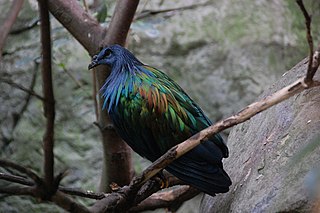
The Nicobar pigeon or Nicobar dove is a bird found on small islands and in coastal regions from the Andaman and Nicobar Islands, India, east through the Indonesian Archipelago, to the Solomons and Palau. It is the only living member of the genus Caloenas alongside the extinct spotted green pigeon, and is the closest living relative of the extinct dodo and Rodrigues solitaire.

The Nicobar Islands rain forests is a tropical moist broadleaf forest ecoregion in the Nicobar Islands. The Nicobar Islands are in the Indian Ocean, lying north of Sumatra and south of the Andaman Islands. The islands are politically part of India, although physically closer to Southeast Asia. Millions of years of isolation from the mainland has given rise to a distinct flora and fauna, including many endemic species.

Coccothrinax is a genus of palms in the family Arecaceae. There are more than 50 species described in the genus, plus many synonyms and subspecies. A new species was described as recently as 2017. Many Coccothrinax produce thatch. In Spanish-speaking countries, guano is a common name applied to Coccothrinax palms. The species are native throughout the Caribbean, the Bahamas, extreme southern Florida and southeastern Mexico, but most of the species are known only from Cuba.

Arenga is a genus of palms, native to Southeast Asia, southern China, New Guinea, and northern Australia. They are small to medium-sized palms, growing to 2–20 m tall, with pinnate leaves 2–12 m long. Arenga palms can grow in areas with little sunlight and relatively infertile soil.
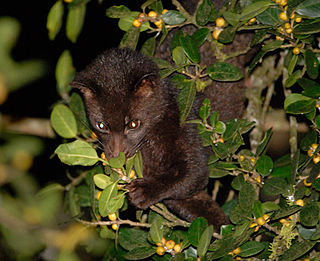
The brown palm civet, also called the Jerdon's palm civet, is a viverrid endemic to the Western Ghats of India.

Bentinckia condapanna, the hill areca nut, is a species of flowering plant in the family Arecaceae. It is found only in India. It is threatened by habitat loss. This palm is mainly found in the evergreen forests of Western Ghats of India.

Bentinckia nicobarica is a species of flowering plant in the family Arecaceae found to occur in the Nicobar group of islands in the Bay of Bengal. It is an endemic palm occurring in Great Nicobar, Katchal, Nancowry and Car Nicobar Islands.

Borassodendron is a genus of flowering plant in the family Arecaceae. It contains two species, native to Southeast Asia.

Chuniophoenix is a genus of palm tree named after Chun Woon-Young, then director of the Botanical Institute, Sun Yat Sen University, Guangzhou. It contains three known species, native to southern China and Vietnam. Chuniophoenix is a member of tribe Chuniophoeniceae, a small group of palms that exhibit great morphological diversity and interesting biogeography. The tribe includes four genera: Chuniophoenix with 3 species in China and Vietnam, Kerriodoxa (monotypic) in Peninsular Malaysia and Thailand, Nannorrhops (monotypic) from Arabia to Afghanistan, and Tahina (monotypic) in Madagascar.

Wallichia was a genus of seven species of flowering plant in the family Arecaceae. Its species are now included within the genus Arenga.

Archontophoenix cunninghamiana – commonly known as Bangalow palm, king palm, Illawara palm or piccabeen palm – is a tree in the palm family Arecaceae which is endemic to the east coast of New South Wales and Queensland, Australia.
Aphandra is a monotypic genus of flowering plant in the palm family native to the Amazon rainforest vegetation in South America. Its only species is Aphandra natalia, sometimes called mastodon palm or fiber palm, and is used by indigenous peoples in the construction of brooms and other products. This plant is commercially exploited for its edible fruits, and for its leaf sheath and petiole fibers. This fiber is almost equal to the fiber extracted from Attalea funifera and Leopoldinia piassaba, which is called piassava.

Kerriodoxa elegans, the white backed palm, is the only species of palm tree in the genus Kerriodoxa, in the family Arecaceae.
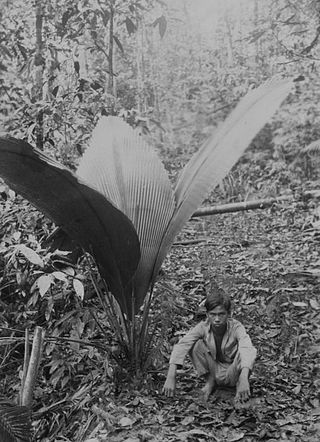
Johannesteijsmannia is a genus of four species of palms found in tropical rainforests of the Malay Peninsula, Borneo and northern Sumatra. They are fan palms, usually growing without a trunk. The genus was named in honor of Johannes Elias Teijsmann, a Dutch botanist who was director of the Bogor Botanical Gardens from 1830 to 1869.
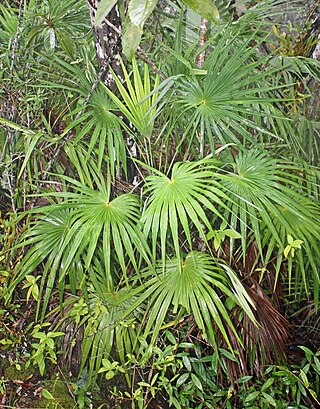
Maxburretia is a genus of three rare species of palms found in southern Thailand and Peninsular Malaysia. The genus is named in honor of Max Burret, a German botanist.

Cryosophileae is a tribe of palms in the subfamily Coryphoideae. The tribe ranges from southern South America, through Central America, into Mexico and the Caribbean. It includes New World genera formerly included in the tribe Thrinacinae, which was split after molecular phylogenetic studies showed that Old World and New World members of the tribe were not closely related.
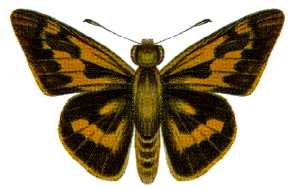
Cephrenes augiades, the orange palm dart, is a butterfly of the family Hesperiidae. It is found from Indonesia to the Solomons.
Areceae is a palm tree tribe in the family Arecaceae.

Chuniophoeniceae is a tribe of palms in subfamily Coryphoideae of plant family Arecaceae. The four genera within the tribe are morphologically dissimilar and do not have overlapping distributions. Three of the genera are monotypic, while the fourth genus (Chuniophoenix) has three species.



















